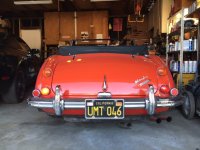bob hughes
Luke Skywalker
Offline
I was stopped at the traffic lights the other day and a friend of mine pulled up along side and asked if my electrics were 6 or 12 volts I told him 12V and asked why, he said that the stop lights looked a bit dim.
I rewired the lights in 2013 and thought that I had it right but following his comments I am beginning to wonder if I have indeed wired the lights the right way around. The car is a BJ7 so we are on the early wiring system - the bulbs are 6/21. Which drives the 6 amp side and which should drive the 21 amp side. I think that I wired it up so that 21 amps supplied the side lights and the 6 amp supplied the stop/indicators.
Just checked on the car and swipe me - the brake lights are not working. It has happened before so I will have to check the system out, but the above question still applies.

Bob
I rewired the lights in 2013 and thought that I had it right but following his comments I am beginning to wonder if I have indeed wired the lights the right way around. The car is a BJ7 so we are on the early wiring system - the bulbs are 6/21. Which drives the 6 amp side and which should drive the 21 amp side. I think that I wired it up so that 21 amps supplied the side lights and the 6 amp supplied the stop/indicators.
Just checked on the car and swipe me - the brake lights are not working. It has happened before so I will have to check the system out, but the above question still applies.

Bob

 Hi Guest!
Hi Guest!

 smilie in place of the real @
smilie in place of the real @
 Pretty Please - add it to our Events forum(s) and add to the calendar! >>
Pretty Please - add it to our Events forum(s) and add to the calendar! >> 



